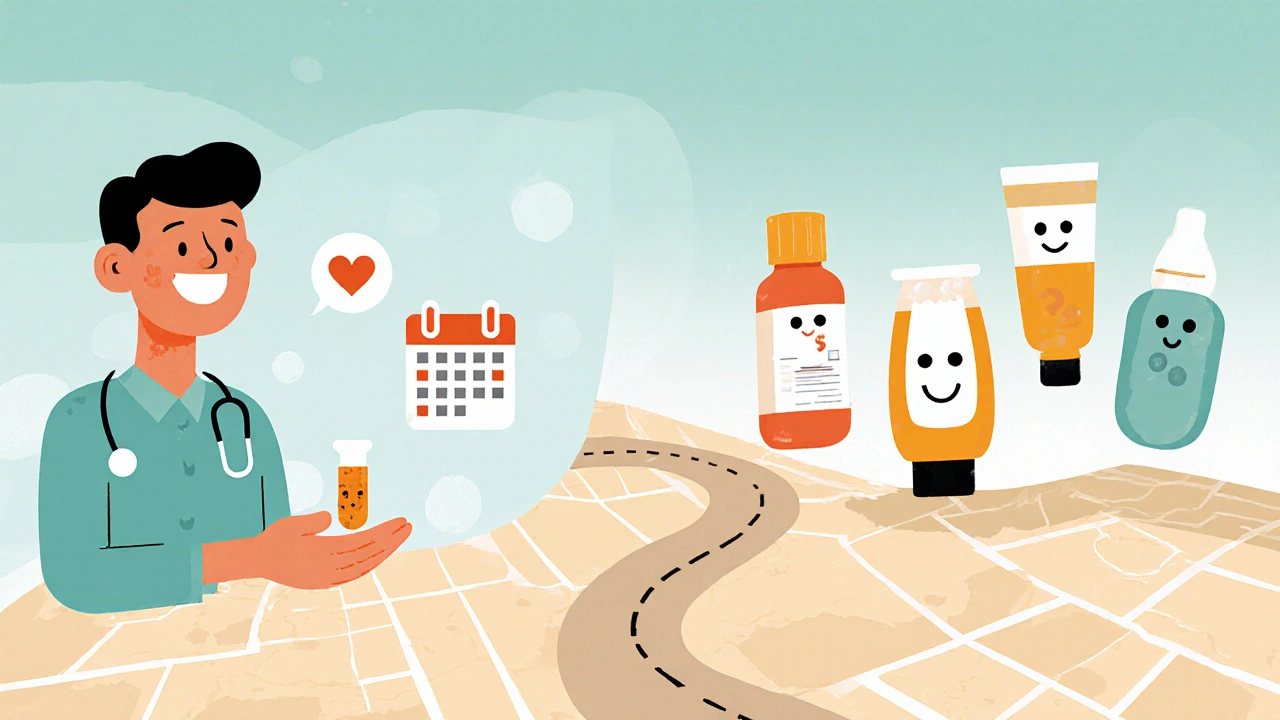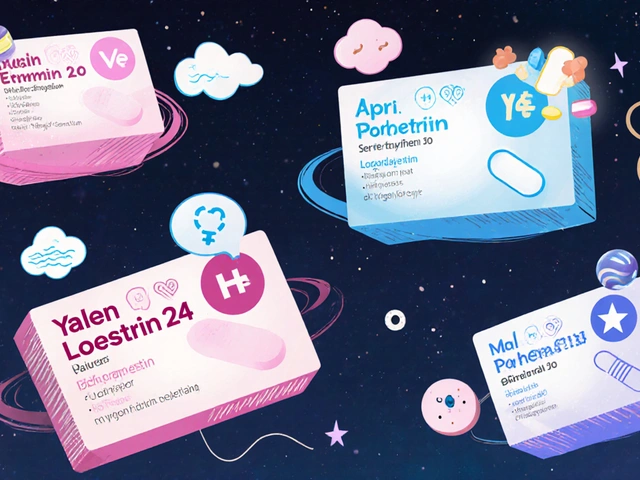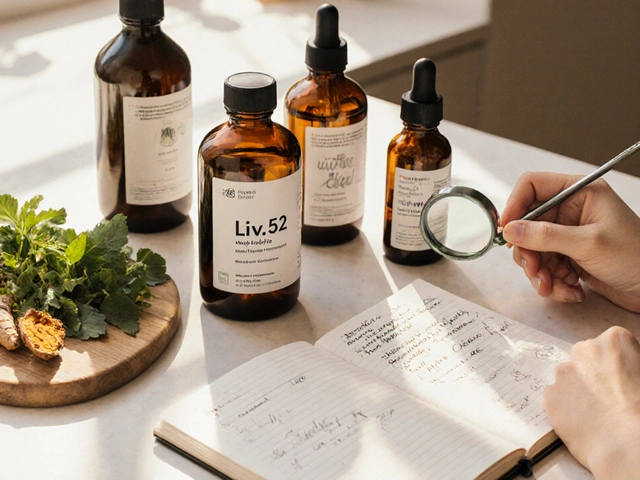Acne Treatment Decision Tool
Choose your key factors
Answer these questions to find the most suitable acne treatment for your situation
Recommended Treatment Options
Treatment Comparison
| Feature | Recommended Option | Isotretinoin |
|---|---|---|
| Effectiveness | 80-90% clearance | |
| Side Effects | Dry skin, cheilitis, liver enzyme rise, mood changes | |
| Cost | $200-$400/month + lab fees | |
| Pregnancy Safety | Category X - absolutely contraindicated |
When acne doesn’t respond to over‑the‑counter gels, many patients wonder whether a strong retinoid like isotretinoin (often sold as Isotroin) is the right step or if gentler alternatives could do the job. This guide breaks down isotretinoin side‑effects, efficacy and cost, then lines it up against the most common oral and topical substitutes so you can decide what matches your skin, lifestyle and health profile.
Isotretinoin is a synthetic form of vitamin A acid that targets the root causes of severe nodular acne by reducing sebum production, normalising skin cell turnover and dampening inflammation. Marketed under brand names such as Accutane, Roaccutane and the generic label Isotroin, it is the only FDA‑approved drug that can achieve long‑term remission in most patients with severe cystic acne.How Isotretinoin Works
Isotretinoin binds to retinoic acid receptors (RAR) in the skin’s sebaceous glands. This binding shuts down the gene pathways that tell glands to churn out oily sebum, a key food source for the acne‑causing bacterium Cutibacterium acnes. By shrinking gland size and reducing keratinocyte clumping, the drug also prevents the formation of comedones (blackheads and whiteheads). The result is a dramatic cut in lesion count-clinical trials report up to 80‑90% clearance after a 4‑6 month course.
Why Patients Look for Alternatives
Despite its potency, isotretinoin carries a baggage of potential drawbacks. The drug is Isotretinoin alternatives often sought because of strict pregnancy restrictions, the need for regular blood work, and a side‑effect profile that can include dry skin, elevated liver enzymes, mood changes and, in rare cases, inflammatory bowel disease. Insurance coverage varies, and the high cost of the medication plus monitoring can be prohibitive. For those with milder acne, the risk‑benefit balance may tilt in favor of less aggressive options.
Side‑Effect Snapshot
- Dry lips and skin (up to 100% of users)
- Temporary worsening of acne during the first few weeks
- Elevated triglycerides and liver enzymes-requires monthly labs
- Potential mood disturbances; patients should report any depression or anxiety
- Teratogenicity - strict contraception needed for women of child‑bearing age

Comparison Table: Isotretinoin vs. Common Alternatives
| Drug | Mechanism | Route & Typical Regimen | Effectiveness for Severe Acne | Common Side Effects | Pregnancy Risk |
|---|---|---|---|---|---|
| Isotretinoin | Oral retinoid - reduces sebum, normalises keratinisation | Oral capsule, 0.5‑1 mg/kg/day for 4‑6 months | 80‑90% lesion clearance | Dry skin, cheilitis, liver enzyme rise, mood changes | Category X - absolutely contraindicated |
| Doxycycline | Oral tetracycline antibiotic - anti‑inflammatory | 100‑200 mg once or twice daily for 3‑6 months | 30‑50% improvement in moderate‑severe acne | Photosensitivity, gastrointestinal upset, rare esophagitis | Category D - avoid in 2nd/3rd trimester |
| Tretinoin | Topical retinoid - normalises skin turnover | Gel/cream, applied nightly | Effective for comedonal acne, 20‑30% reduction in lesions | Local irritation, peeling, photosensitivity | Category C - limited data, generally avoided in pregnancy |
| Benzoyl peroxide | Oxidising agent - kills C. acnes, reduces inflammation | 2‑5 % gel or wash, once or twice daily | 10‑20% lesion reduction; often combined with other agents | Dryness, bleaching of fabrics, mild irritation | Category B - considered safe in pregnancy |
| Azelaic acid | Organic acid - anti‑keratinising, antimicrobial | 15‑20 % cream, twice daily | 15‑25% reduction; helpful for rosacea‑type acne | Mild burning, itching | Category B - safe during pregnancy |
Deep Dive into Popular Alternatives
Doxycycline - Oral Antibiotic
Doxycycline is often the first prescription for inflammatory acne that hasn’t responded to topical therapy. It works by dampening the inflammatory cascade rather than shrinking the sebaceous gland. Courses typically last three to six months, after which many patients see a plateau and need a maintenance plan. It’s inexpensive, but the risk of photosensitivity means you’ll need diligent sunscreen use.
Tretinoin - Topical Retinoid
Tretinoin is the gold‑standard for comedonal acne. Applied nightly, it promotes exfoliation of dead skin cells and prevents pore blockage. New users often experience a “retinoid purge” where existing lesions temporarily worsen-a sign the drug is working. It’s safe for most adults but should be avoided by anyone who’s pregnant or planning pregnancy.
Benzoyl peroxide - Over‑the‑counter Oxidiser
This is the most widely available acne ingredient. It can be used alone for mild breakouts or combined with antibiotics or retinoids for moderate disease. Because it kills bacteria on contact, resistance is rare. The main complaint is skin dryness, which is easy to manage with a good moisturizer.
Azelaic acid - Multifunctional Acid
Azelaic acid targets both bacterial growth and abnormal keratinisation. It’s a good middle‑ground for people who find retinoids too irritating but need more than benzoyl peroxide can offer. It also improves post‑inflammatory hyperpigmentation, making it popular for darker skin tones.
Photodynamic therapy (PDT) - Light‑Based Procedure
PDT involves applying a photosensitising gel to the skin and exposing it to a specific wavelength of light. The reaction kills acne‑driving bacteria and shrinks sebaceous glands. It’s a one‑to‑two‑session option for patients who dislike daily pills or creams. However, it’s costly and can cause temporary redness.
Laser resurfacing - Cosmetic Laser
Fractional lasers create micro‑thermal zones in the skin, prompting collagen remodelling and reducing oil production. Results can be dramatic, but multiple sessions are usually needed, and downtime can be a week or more per treatment.
Choosing the Right Path: Decision Guide
- Severe nodular or cystic acne: Isotretinoin is the most effective single therapy. Consider it if you’ve exhausted oral antibiotics and topical retinoids.
- Moderate inflammatory acne with minimal scarring risk: Oral doxycycline or a combination of benzoyl peroxide + topical retinoid often works well.
- Comedonal (blackhead/whitehead) dominant acne: Tretinoin or adapalene provides strong results with lower systemic risk.
- Pregnant or planning pregnancy: Avoid isotretinoin and doxycycline. Benzoyl peroxide, azelaic acid and certain topical retinoids (under specialist guidance) are safer.
- Intolerant to dryness or irritation: Start with low‑strength benzoyl peroxide or azelaic acid, and add moisturiser liberally.
- Budget‑conscious: Generic doxycycline and over‑the‑counter benzoyl peroxide are the cheapest options. Isotretinoin can cost $200‑$400 per month plus lab fees.

Monitoring and Follow‑Up
Any systemic acne treatment should involve regular check‑ins with a dermatologist. For isotretinoin, labs are drawn at baseline, then every 4‑6 weeks to track liver enzymes and lipid levels. Women must enroll in a pregnancy‑prevention programme (iPLEDGE in the U.S., similar schemes elsewhere). Oral antibiotics usually need a liver function test at the start and after three months. Topicals require less formal monitoring but should be reviewed for irritation or worsening acne.
Potential Pitfalls and How to Avoid Them
- Skipping labs - Missing a blood test can let liver issues go unnoticed.
- Inconsistent use - Acne medication works best with steady, daily application or dosing.
- Not using sunscreen - Retinoids and doxycycline increase photosensitivity, leading to sunburn.
- Discontinuing too early - Stopping isotretinoin after 2 months often results in relapse; the full course is crucial.
- Ignoring mental health cues - Mood changes can be subtle; talk to your doctor if you feel down.
Bottom Line
If you have life‑changing cystic acne and are prepared for regular labs and strict contraception, isotretinoin remains the gold standard. For everyone else, a step‑wise approach-starting with topical benzoyl peroxide, adding an oral antibiotic if needed, and reserving isotretinoin for refractory cases-offers a balanced blend of effectiveness and safety.
Can I use isotretinoin if I’m pregnant?
No. Isotretinoin is classified as a Category X teratogen. It can cause severe birth defects, so women must use two reliable forms of contraception and undergo regular pregnancy tests throughout treatment.
How long does a typical isotretinoin course last?
Most courses run for 4‑6 months, delivering a cumulative dose of 120‑150 mg/kg. Some patients may need a second round if acne returns.
Are there over‑the‑counter alternatives that work as well?
OTC options like benzoyl peroxide and salicylic acid help mild to moderate acne but don’t match isotretinoin’s remission rates for severe cystic cases.
What monitoring is required for doxycycline?
A baseline liver function test is advisable, plus a repeat after three months. Watch for signs of sunburn and avoid excessive UV exposure.
Can I combine isotretinoin with other acne meds?
Yes, dermatologists often pair isotretinoin with topical benzoyl peroxide or a gentle moisturizer to reduce dryness. Combining with oral antibiotics is usually unnecessary and can increase side‑effect burden.






Nathan S. Han
23 October, 2025 . 23:01 PM
Embarking on an isotretinoin regimen is more than a prescription; it is a partnership between you and your dermatologist. The medication’s potency demands a disciplined approach to skin care, hydration, and sun protection. Consistent use of a non‑comedogenic moisturizer can mitigate the notorious dryness and keep the skin barrier intact. Regular laboratory monitoring safeguards liver function and lipid levels, turning potential complications into manageable checkpoints. Remember, the psychological uplift that accompanies clear skin often mirrors the dedication you invest throughout the treatment.
Ed Mahoney
24 October, 2025 . 00:24 AM
Oh wow, another pep talk about moisturizin' and labs – as if we all have nothing better to do than schedule blood draws. Sure, let's add "stay hydrated" to the list right after "don't eat the cat". Missin' the point? Nah, just love the drama.
Brian Klepacki
24 October, 2025 . 02:38 AM
One must consider the philosophical gravitas of invoking a molecule as potent as isotretinoin upon the epidermal frontier. It is not merely a pill; it is an alchemical covenant, a pact forged in the crucible of dermatologic ambition. The very act of reducing sebaceous gland activity resonates with the ancient desire to dominate chaos, to tame the oily tempest that has long plagued the visage of humankind. While the pharmacologic cascade silences Cutibacterium acnes, it also whispers an elegy to the skin's natural oil, a sacrifice demanded by the pursuit of flawless complexion. The tyrannical side‑effects-cheilitis, hepatic perturbations, lipid upheavals-are not mere inconveniences but the corporeal echo of a grandiose transformation. Yet, in the theater of severe nodular acne, such tributes are warranted, for the alternative is a perpetual battlefield of cystic eruptions. Patients must therefore adopt a regimen of vigilance, engaging in monthly spectroscopic assays to monitor hepatic sanctity and lipid equilibrium, lest the very cure become the affliction. Moreover, the iPLEDGE protocol, with its dual‑contraceptive edicts, serves as a moral compass, steering the fertile from the brink of teratogenic catastrophe. In juxtaposition, the modest alternatives-tetracycline, benzoyl peroxide, azelaic acid-play the role of the humble understudy, commendable yet devoid of the starring allure that isotretinoin commands. Thus, the decision matrix transcends mere efficacy; it becomes an existential deliberation, a dialogue between risk and reward, between fleeting inconvenience and lasting liberation. In the final analysis, to embrace isotretinoin is to accept a metamorphosis that is at once brutal and liberating, a rite of passage for those who dare to confront their dermal destiny.
Selina M
24 October, 2025 . 04:18 AM
i totally get the drama but honestly isotretinoin can be a game changer if you follow the plan. just keep up with the labs and moisturize a lot and you'll see the glow. dont forget sunscreen becuz ur skin will be super sensitive. good luck!
Nicholai Battistino
24 October, 2025 . 06:14 AM
If cost is a primary concern, begin with a generic doxycycline course and add benzoyl peroxide as needed. This approach balances affordability with respectable efficacy.
Katherine Collins
24 October, 2025 . 07:21 AM
meh just pick benzoyl :)
Taylor Nation
24 October, 2025 . 08:44 AM
When weighing isotretinoin against other options, consider both the severity of the acne and your lifestyle constraints. A systematic approach-starting with topical agents, then moving to oral antibiotics before contemplating isotretinoin-often yields the best risk‑benefit profile. Keep communication open with your dermatologist to tailor monitoring frequency to your individual response. Ultimately, the goal is clear skin without compromising overall health.
Joey Yap
24 October, 2025 . 09:34 AM
Reflecting on the hierarchy of treatments invites us to ponder the nature of patience itself. Each step-topical, oral, systemic-mirrors a meditation on incremental progress. By honoring the process rather than fixating on immediate results, one cultivates resilience. Thus, the journey to clearer skin can also become a subtle practice in mindful acceptance.